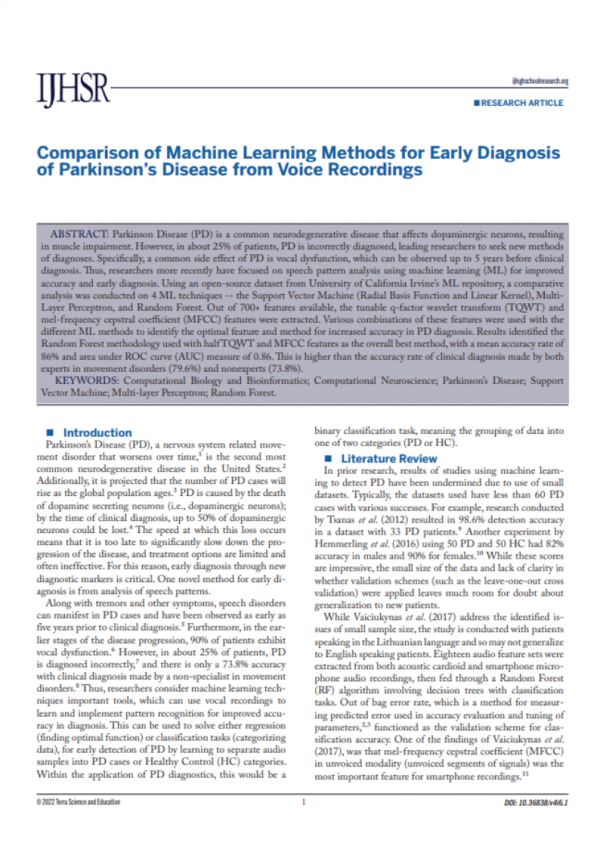|

Publishing high school research is an excellent way to establish the credibility of your work. However, deciding where to publish can be challenging, especially for students conducting research for the first time. There are various journals that accept high school-level research. Among them, one of the most recommended for high school students is the International Journal of High School Research (IJHSR). Today, we'll explore detailed information about the IJHSR journal and the requirements for publication.
International Journal of High School Research (IJHSR)
What is IJHSR? The International Journal of High School Research (IJHSR) publishes student research in the fields of behavioral and social sciences, technology, engineering, and mathematics. This journal is published by the non-profit organization Terra Science and Education, which also organizes the Genius Science Olympiad. IJHSR is reviewed by university professors, STEM experts, researchers, and Ph.D. students and follows a rolling submission policy. The journal has been in publication since 2019, and all accepted papers are internationally indexed by EBSCO, making them searchable in most libraries worldwide. It is particularly recommended for students conducting literature reviews in STEM fields.
Review Process & Acceptance Rate Typically, IJHSR assigns three reviewers to evaluate a paper, providing high-level feedback for research papers. About 50% of papers submitted to IJHSR are accepted. However, this relatively high acceptance rate can seem misleading due to the challenging submission process. Many students do not submit papers to this journal due to difficulties in finding suitable reviewers. For those who do, the acceptance rate can be around 20-30% among initial submissions, with some achieving the 50% acceptance rate after finding appropriate reviewers.
IJHSR Formatting Guidelines The formatting guidelines for IJHSR are similar to those of many other journals. Given the strict formatting guidelines, it is recommended to use the official template and paste your text according to the specified format. There are two different templates, one for review articles and one for original research, so use the appropriate template for your study.
- Font: All papers must be submitted in Arial font. - Body/Paragraph Text: 10pt font - Subheadings: 12pt font, italicized, bold - Section Headings: 14pt font, bold - Title: 16pt font, bold - Line Spacing: The document should have single line spacing, and paragraphs should not be indented.
Publication Fees There is no fee to submit a paper, but if the paper is accepted for publication, a fee of $250 is charged.
Submission Process The submission process can take 4-8 months from initial submission to publication, depending on the number of revisions required and the speed of resubmission. However, it often takes about a year for students to finalize publication. At 'Final Submission' stage, you need to provide the names of three reviewers who should be experts not involved in your research. These can be individuals referenced in your paper or people you admire or wish to collaborate with in the future.
Timeline After submitting the final draft via email, the detailed submission and review process is as follows: - Format Check: The editor reviews the submitted paper for correct formatting, style, plagiarism, and citations (using the template). - Review Stage: Once formatting is confirmed, the editor assesses whether the paper is scientifically valid and suitable for publication. If agreed upon, the paper is sent to at least two external reviewers with expertise in the field for independent scientific opinions. - Feedback Integration: Reviewers may request revisions or reject the paper. The editor will ask for modifications based on reviewer feedback (usually within 30 days). - Payment: After submission of revisions and full acceptance, the publication fee is charged. - Final Revisions: The paper is sent to a copy editor for final preparation. Authors receive a proof to check for errors, and the paper is only published after final approval.
Example of a Published Paper An example of a published paper involves a student researching methods for early diagnosis of Parkinson’s disease using voice pattern analysis and machine learning. Understanding the process of publication at IJHSR is best achieved by reading papers published by students and reviewing their experiences from start to finish.

How long did it take to write your paper? "The process started in December 2021 and took about 5 months to complete by April 2022. My paper was based on original research and experiments, which extended the timeline significantly due to additional procedures like ethics board approval and survey design." What tips would you give for submitting to IJHSR? 1. Contact Reviewers in Advance: One unique aspect of IJHSR is the requirement to contact and get consent from three professors or postdoctoral researchers who will review your paper. This can be time-consuming, so start early in the research process (contact at least 50 people). 2. Literature Review Challenges: IJHSR allows literature reviews but notes that these submissions are more competitive and limited to 2-3 articles on specific topics. 3. Find a Mentor: Writing a research paper is academically intensive, and having a mentor who provides critical feedback and helps with the complex literature is crucial. 4. Review Formatting Guidelines Carefully: IJHSR has detailed formatting guidelines, from citing references to including diagrams. Repeatedly check these guidelines to avoid unnecessary publication delays (using templates is highly recommended). 5. Have a Backup Plan: Even if you think your paper is strong, prepare alternative options. Consider journals with higher acceptance rates and faster processing times, such as the National High School Journal of Science. |
 Click here to book
Click here to book